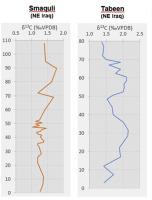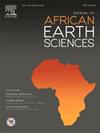Paleoenvironmental conditions across the Coniacian-Santonian in the Kometan Formation, northeastern Iraq: Insights from planktonic foraminifera distribution, mineralogy and geochemistry
IF 2.2
4区 地球科学
Q2 GEOSCIENCES, MULTIDISCIPLINARY
引用次数: 0
Abstract
The paleoenvironmental conditions during the Coniacian-Santonian interval within the Kometan Formation in northeastern Iraq have been analyzed through the distribution of depth-related planktonic foraminifera in the carbonate rocks (limestone and marly limestone) of the Kometan Formation using standard washing method for soft samples and thin section method for hard samples supported by mineralogical investigations, geochemical analysis and stable isotopic δ13C and δ18O data. The findings indicate that saline marine waters and a hot, dry to semi-arid climate with low to medium oxygen conditions were conducive to deposition, which was characterized by high organic productivity due to marine transgression. The study revealed that the distribution of shallow water forms (SWF) of globular-shaped foraminifera, compared to deep water forms (DWF) of keeled-shaped genera, along with δ13C data from the late Turonian-early Campanian succession, indicated a relatively low sea level throughout the Late Turonian period. The water level began to rise in the early Coniacian, continuing gradually until the late Coniacian, when a noticeable increase in sea level was observed. This elevated sea level persisted through the early and late Santonian periods, before starting to drop. A slight marine transgression was noted at the beginning of the early Campanian period, followed by a significant drop in sea level. During the late Turonian, a subtropical climate prevailed. Temperature increased during the early to middle Coniacian, decreased slightly at the beginning of the late Coniacian, and then rose again at the end of the late Coniacian, indicating a shift from tropical to subtropical climatic conditions. Similar hot climatic conditions persisted in a tropical-subtropical climate during the early to late Santonian and early Campanian, with a relative temperature drop near the end of the early Campanian. No evidence of an oceanic anoxic event (OAE3) was found in the Kometan Formation during the late Coniacian–early Santonian period. The hypothesized event, based on biostratigraphy, facies analysis, stable isotopes, geochemical evidence, and field study, was limited to demonstrating an increase in the ratio of keeled chamber planktonic foraminifera compared to globular chamber ones. This ratio increase of the keeled chamber types is believed to result from a deepening sedimentary environment due to rising sea levels, creating organic matter-rich beds with high productivity and relatively low oxygen conditions during the Coniacian-Santonian boundary.

伊拉克东北部科米坦地层科尼亚期-桑顿期的古环境条件:浮游有孔虫分布、矿物学和地球化学的启示
在矿物学研究、地球化学分析和稳定同位素 δ13C 和 δ18O 数据的支持下,采用软样本标准洗涤法和硬样本薄片法,通过科米坦地层碳酸盐岩 (石灰岩和泥质灰岩)中与深度有关的浮游有孔虫的分布,分析了伊拉克东北部科米坦地层中科 尼阿世-山童期的古环境条件。研究结果表明,含盐海水和中低氧条件下的炎热、干燥至半干旱气候有利于沉积,而沉积的特点是海相侵蚀造成的高有机生产力。研究发现,与龙骨状有孔虫属的深水形态(DWF)相比,球状有孔虫的浅水形态(SWF)的分布,以及晚都仑世-早坎潘世演替的δ13C 数据表明,整个晚都仑世时期的海平面相对较低。海平面在海盆纪早期开始上升,并逐渐持续到海盆纪晚期,此时海平面明显上升。海平面的上升一直持续到山顿纪早期和晚期,然后开始下降。在坎帕尼亚早期,海平面略有下降,随后海平面显著下降。在都龙纪晚期,亚热带气候盛行。气温在冠亚纪早中期有所上升,冠亚纪晚期开始时略有下降,冠亚纪晚期结束时又有所上升,表明气候条件已从热带转向亚热带。在山顿纪早期至晚期以及坎盘纪早期,类似的炎热气候条件在热带-亚热带气候条件下持续存在,坎盘纪早期末期温度相对下降。在科米坦构造中没有发现科尼亚期晚期-山统早期发生过海洋缺氧事件(OAE3)的证据。根据生物地层学、岩相分析、稳定同位素、地球化学证据和实地考察,假设的事件仅限于证明龙骨状腔浮游有孔虫的比例比球状腔浮游有孔虫的比例有所增加。龙骨腔类型有孔虫比例的增加被认为是海平面上升导致沉积环境加深的结果,在科尼阿克-山口迭纪边界形成了富含有机质的海床,具有高生产力和相对低氧的条件。
本文章由计算机程序翻译,如有差异,请以英文原文为准。
求助全文
约1分钟内获得全文
求助全文
来源期刊

Journal of African Earth Sciences
地学-地球科学综合
CiteScore
4.70
自引率
4.30%
发文量
240
审稿时长
12 months
期刊介绍:
The Journal of African Earth Sciences sees itself as the prime geological journal for all aspects of the Earth Sciences about the African plate. Papers dealing with peripheral areas are welcome if they demonstrate a tight link with Africa.
The Journal publishes high quality, peer-reviewed scientific papers. It is devoted primarily to research papers but short communications relating to new developments of broad interest, reviews and book reviews will also be considered. Papers must have international appeal and should present work of more regional than local significance and dealing with well identified and justified scientific questions. Specialised technical papers, analytical or exploration reports must be avoided. Papers on applied geology should preferably be linked to such core disciplines and must be addressed to a more general geoscientific audience.
 求助内容:
求助内容: 应助结果提醒方式:
应助结果提醒方式:


